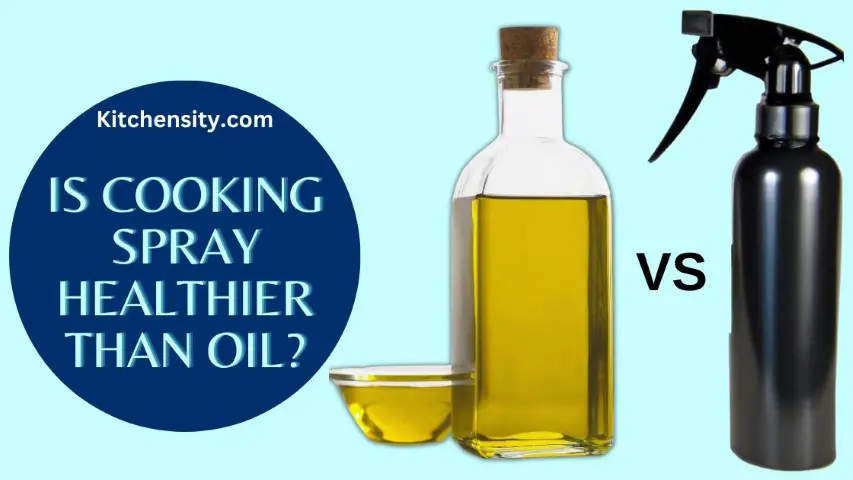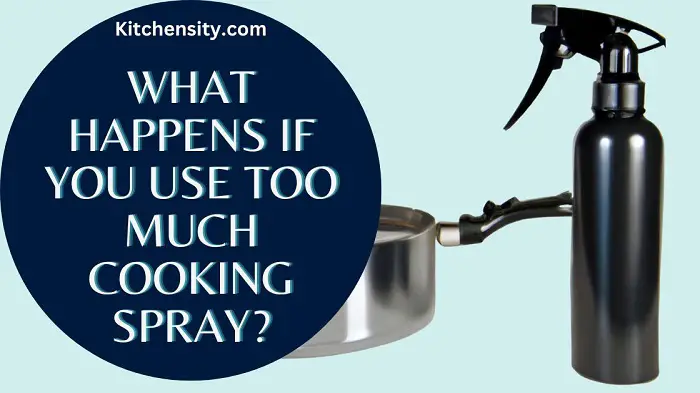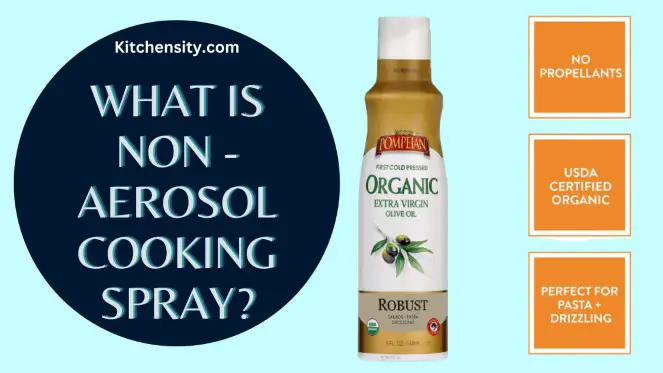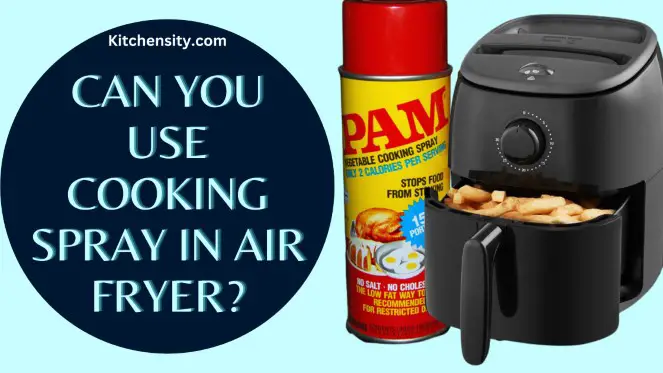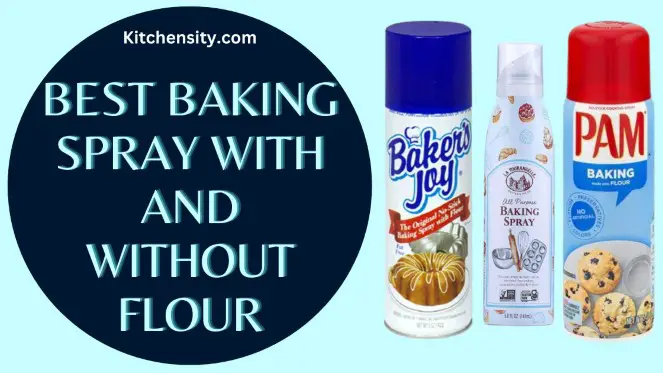When it comes to cooking and baking, there are many ingredients and fats that can help make the process easier and more efficient.
One such fat is a cooking spray, often used to prevent food from sticking to surfaces and help with the cooking or baking process.
However, not all cooking sprays are created equal, and it’s important to understand the difference between baking spray and cooking spray, and when to use each.
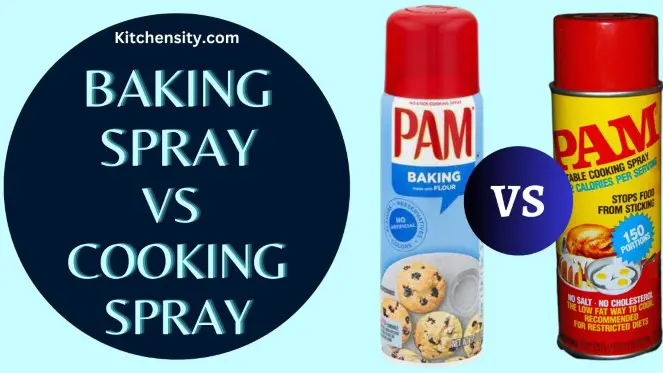
Table of Contents
- 1 Baking Spray Vs Cooking Spray: The Major Difference
- 2 What Is Cooking Spray?
- 3 What Is Baking Spray?
- 4 Baking Spray Vs Cooking Spray: Which One Is Better?
- 5 Can I Use Baking Spray Instead Of Cooking Spray?
- 6 How To Properly Store Cooking Spray Or Baking Spray?
- 7 Tips For Using Cooking and Baking Spray
- 8 User’s Tips And Experiences
- 9 Safety Precautions When Using Cooking Spray or Baking Spray
- 10 Conclusion
- 11 You May Also Like
- 12 FAQs
Baking Spray Vs Cooking Spray: The Major Difference
Baking spray, specifically designed for baking, includes additional ingredients like flour to prevent baked goods from sticking to pans and ensure an even release. Cooking spray, on the other hand, is a versatile option that can be used in various cooking techniques to prevent food from sticking to surfaces.
Let us now delve into the topics to gain a comprehensive understanding.
Also Read – Does Pam Cooking Spray Contain Butane?
What Is Cooking Spray?
Cooking spray is a type of oil spray that is used to prevent food from sticking to surfaces such as pans, grills, and baking sheets. It is typically made with vegetable oil or canola oil and sometimes includes additional ingredients such as lecithin, dimethyl silicone, and propellants.
It is a popular alternative to traditional cooking oils, as it is often lower in calories and fat and can be used in smaller amounts.
Benefits Of Using Cooking Spray
Using cooking spray offers several benefits, including:
- Preventing food from sticking to surfaces.
- Reducing the amount of oil needed in recipes.
- Helping to distribute heat evenly.
- Have lower calories and fats.
When To Use Cooking Spray?
- Cooking spray is typically used in situations where food is likely to stick to surfaces, such as when grilling, sautéing, or baking.
- It can also be used to add a light layer of oil to vegetables before roasting or to prevent egg whites from sticking to mixing bowls.
Also Read – How To Remove Cooking Spray Residue?
What Is Baking Spray?
The baking spray is a specific type of cooking spray that is designed for use in baking. It typically includes additional ingredients such as flour, which helps to prevent baked goods from sticking to pans and ensures an even release. It may also include other ingredients such as lecithin and propellants.
Also Read – Best Baking Spray With Flour And Without Flour
Benefits Of Using Baking Spray
Using baking spray offers several benefits, including:
- Preventing baked goods from sticking to pans
- Ensuring an even release
- Reducing the need for additional flour or grease in recipes
- Saving time and effort in the baking process
When To Use Baking Spray?
- The baking spray is typically used in situations where baked goods are likely to stick to pans, such as when making cakes, muffins, or bread.
- It can also be used to prepare bundt pans, loaf pans, and other specialty baking dishes.
Also Read – What Cooking Spray is Best for Air Fryer?
Baking Spray Vs Cooking Spray: Which One Is Better?
Baking and cooking sprays are both versatile tools that can help you in the kitchen, but they have some key differences.
The baking spray is typically a combination of oil and flour, while the cooking spray is usually just oil. This difference in composition can affect the results you get when using each spray.
The baking spray is designed to prevent baked goods from sticking to the pan and to help them release easily. The flour in the spray creates a barrier between the pan and the batter, helping to prevent sticking. It also usually contains a small amount of leavening agent, which can help baked goods rise.
On the other hand, cooking spray is designed to coat surfaces evenly and prevent sticking, making it a useful tool for grilling, sautéing, and frying. It can also be used in baking, but it may not offer the same level of non-stick protection as a baking spray.
When it comes to choosing between baking and cooking spray, it’s important to consider the recipe and the surface you’ll be using. If you’re making a cake or other baked goods, using a baking spray can help ensure that the finished product is easily released from the pan. If you’re cooking on a non-stick surface, cooking spray may be a better option.
Also Read – Cooking Spray That Doesn’t Leave Residue
It’s also important to choose a high-quality spray that’s appropriate for your needs. Look for sprays that are made with healthy oils and avoid those that contain added sugars or artificial flavors. Reading the label carefully can help you make an informed decision and choose the best spray for your needs.
In addition to using baking and cooking sprays, there are other tips and tricks you can use to prevent sticking and ensure even cooking.
For example, using parchment paper or silicone baking mats can help prevent sticking, while preheating your pan can help ensure even cooking.
Overall, both baking and cooking sprays can be useful tools in the kitchen. By choosing the right spray for the recipe and using it properly, you can help ensure that your food turns out perfectly every time.
Here’s a comparison table to help illustrate the differences between baking spray and cooking spray:
| Criteria | Baking Spray | Cooking Spray |
|---|---|---|
| Composition | Oil and flour mixture | Mostly just oil |
| Purpose | Prevent sticking in baking | Prevent sticking in cooking |
| Non-stick effect | High | Medium to high |
| Leavening agent | Often contains a small amount | No leavening agent |
| Best use | Baking cakes, muffins, etc. | Cooking on non-stick surfaces |
| Other uses | Can also be used for cooking | Can also be used for baking |
| Recommended oil type | Vegetable oil or canola oil | Healthy oils such as olive oil or coconut oil |
Also Read – Best Zero-Calorie Cooking Spray
Can I Use Baking Spray Instead Of Cooking Spray?
While baking spray can be used in cooking, it may not always be the most effective substitute for cooking spray due to its specific formulation.
Baking Spray As A Substitute For Cooking Spray
- Baking spray can be used as a substitute for cooking spray in certain situations, but it may not offer the same level of non-stick protection or even coating.
- The baking spray is specifically designed for baking, with additional ingredients like flour that help prevent baked goods from sticking to pans. It is particularly effective for delicate or intricate baking molds and specialty baking dishes.
- When using the baking spray as a substitute for cooking spray, keep in mind that it may not provide the same results for cooking techniques like grilling, sautéing, or frying, where a more even and thorough coating is desired.
Also Read – What Can I Use Instead Of Cooking Spray?
Considerations For Substituting Baking Spray
- Non-Stick Effect:
- Cooking spray is designed to evenly coat surfaces and prevent sticking in a broader range of cooking techniques.
- Baking spray flour content may not provide the same level of non-stick protection outside of baking scenarios.
- Surface and Recipe:
- Consider the surface you’re cooking on and the specific recipe requirements.
- For example, if you’re working with a non-stick surface, cooking spray may still be the preferred option as it is designed to enhance the non-stick properties of such surfaces.
- Desired Results: Evaluate the desired outcome of your cooking. If you’re aiming for a specific texture, browning, or crispness, cooking spray may be better suited to achieve those results.
In general, while baking spray can be used as a substitute for cooking spray in certain cases, it’s important to consider the specific needs of your recipe and cooking technique.
Opting for the appropriate spray will help ensure the best results and prevent any potential issues with sticking or uneven coating.
Also Read – Best Cooking Sprays For Eggs
How To Properly Store Cooking Spray Or Baking Spray?
Proper storage and shelf life of the cooking spray and baking spray are essential to maintain their quality and effectiveness.
- Storage:
- Cooking spray and baking spray should be stored in a cool, dry place away from heat sources, direct sunlight, and flames. Excessive heat can affect the quality and functionality of the spray.
- Ideally, store the spray at room temperature (around 70°F or 21°C). Avoid storing it in areas with high humidity or temperature fluctuations, such as near stoves, ovens, or refrigerators.
- Ensure that the spray can is tightly closed when not in use to prevent air exposure and maintain the spray’s propellant integrity.
- Shelf Life:
- The shelf life of the cooking spray and baking spray can vary depending on the brand and formulation. It is essential to check the manufacturer’s guidelines for specific information.
- In general, most cooking sprays have a shelf life of about one to two years from the date of manufacture. Baking sprays with added flour may have a slightly shorter shelf life due to the flour component.
- Over time, the effectiveness and non-stick properties of the spray may gradually diminish. If you notice changes in the spray’s performance, such as uneven spraying or decreased non-stick effect, it may be an indication that it has reached its expiration date or deteriorated.
- Quality Concerns:
- Excessive heat or exposure to sunlight can negatively impact the quality of the spray. Heat can cause the spray to expand, leak, or develop an off-putting odor or taste.
- Exposure to sunlight can lead to discoloration, changes in texture, or rancidity.
- It’s important to inspect the spray can before each use. If you notice any signs of damage, such as dents, rust, or leakage, it’s advisable to discard the can, as these can compromise the spray’s safety and quality.
Also Read – Best Cooking Sprays For Gas Grills
Tips For Using Cooking and Baking Spray
Whether you’re using cooking spray or baking spray, there are a few tips to keep in mind:
- Hold the can about 6 inches away from the surface to ensure an even spray
- Use a light, even coat to prevent excess oil or flour from accumulating
- Read the label carefully to ensure that the spray is appropriate for your recipe
- Store the spray in a cool, dry place away from heat and flames
- Shake the can well before each use to ensure that the ingredients are evenly distributed
User’s Tips And Experiences
User Tip 1: Apply Cooking Spray Sparingly
- Many home cooks recommend using cooking spray sparingly to prevent excess oil or flour accumulation. Holding the can about 6 inches away from the surface and using a light, even coat can help achieve better results.
- User Experience: Sarah, an avid home cook, shares, “I’ve found that using too much cooking spray can leave a greasy residue on my pans. By applying a thin, even layer, I get the non-stick benefits without the excess oiliness.”
User Tip 2: Combine Cooking Spray With Other Non-Stick Methods
- Some users suggest combining cooking spray with other non-stick methods for optimal results. For example, using parchment paper or silicone baking mats in addition to cooking spray can further prevent sticking.
- User Experience: John, a professional baker, advises, “When baking cookies, I like to line my baking sheets with parchment paper and then lightly spray the paper with cooking spray. This double layer of non-stick protection ensures easy removal of the cookies every time.”
User Tip 3: Preheat Pans Before Applying Baking Spray
- Preheating pans before applying baking spray can enhance its effectiveness. The heat helps the spray adhere to the surface, creating a better non-stick barrier.
- User Experience: Lisa, a home baker, shares her technique, “I always preheat my cake pans in the oven for a few minutes, then quickly remove them and spray with baking spray. The heat makes the spray cling to the pan, ensuring my cakes release effortlessly.”
User Tip 4: Store Sprays Away From High-Temperature Areas
- Users emphasize the importance of storing cooking spray and baking spray in cool, dry places away from heat sources. Excessive heat can affect the quality and performance of the sprays.
- User Experience: Alex, a passionate cook, advises, “I made the mistake of storing my cooking spray near the stovetop once, and it lost its effectiveness quickly. Now, I always keep it in a cool pantry away from heat, and it lasts much longer.”
Also Read – Kirkland Canola Oil Cooking Spray Review
Safety Precautions When Using Cooking Spray or Baking Spray
When using cooking spray or baking spray, it’s important to follow certain safety precautions to ensure a safe and enjoyable cooking experience. Here are some key guidelines to keep in mind:
- Avoid Flames And Hot Surfaces: Cooking sprays can be flammable, so it’s crucial to avoid spraying them near open flames, hot burners, or heated surfaces. The propellants in the spray can be combustible, leading to fire hazards.
- Read And Follow Instructions: Always read and follow the instructions provided on the spray can. Each product may have specific guidelines for usage, distance, and application. Adhering to these instructions will help you use the spray safely and effectively.
- Ventilation: Ensure proper ventilation in your cooking area when using sprays. Open windows or turn on exhaust fans to allow adequate airflow, especially if using the spray in a confined space.
- Store Properly: Store cooking spray or baking spray in a cool, dry place away from heat sources and direct sunlight. Excessive heat can affect the quality and performance of the spray.
- Shake Well Before Use: Before each use, shake the spray can well to ensure that the ingredients are evenly distributed. This ensures proper functioning and consistent results.
- Keep Out Of Reach Of Children: Like any cooking product, keep cooking spray or baking spray out of the reach of children to prevent accidents or misuse.
Also Read – Best Cooking Spray For Silicone Molds
Conclusion
So, both baking spray and cooking spray can be helpful tools in the kitchen. While cooking spray can be used in many different situations, baking spray is specifically designed for use in baking and may offer better results when making baked goods.
It’s important to choose the right spray for the recipe and to read the label carefully to ensure that you’re using the appropriate ingredients.
Using cooking and baking sprays properly can help prevent food from sticking to surfaces and ensure an even release. These sprays can also help reduce the amount of oil or grease needed in recipes, making them a healthier option.
Whether baking a cake or grilling vegetables, using the right spray can help make the process easier and more efficient.
You May Also Like
- What is Non-Aerosol Cooking Spray?
- Can You Use Cooking Spray On A Cast Iron Skillet?
- Is Cooking Spray Bad for You?
- What Happens If You Use Too Much Cooking Spray?
- Is Cooking Spray Healthier Than Oil?
- What Pans Can You Use Cooking Spray On?
- Can You Use Cooking Spray In An Air Fryer?
FAQs
-
Can I use cooking spray instead of baking spray?
While you can use cooking spray instead of baking spray in some recipes, the baking spray is specifically designed for use in baking and may offer better results.
-
Are cooking sprays healthier than oils?
Cooking sprays can be a healthier option than traditional oils, as they are often lower in calories and fat and can be used in smaller amounts.
-
Can I use baking spray for cooking?
While the baking spray is specifically designed for use in baking, you can use it for cooking as well. However, it may not be the most effective option for all cooking situations.
-
Can I make my cooking spray?
Yes, you can make your cooking spray by mixing oil and a propellant such as alcohol. Or simply pour the oil into a canister or sprayer and use it like a cooking spray.
-
Can I reuse cooking spray?
It is not recommended to reuse cooking spray, as it can lead to the buildup of excess oil or flour on surfaces and may affect the taste and texture of your food.
-
Is Baking Spray The Same As Cooking Spray?
No, baking spray and cooking spray are not the same. The baking spray is specifically designed for baking, with added ingredients like flour to prevent sticking and ensure an even release of baked goods.
Cooking spray is a more versatile option used in various cooking techniques to prevent food from sticking to surfaces.
Katrina Smith is a seasoned expert with over 25 years of experience in all things related to cooking and the kitchen. As an avid cook and kitchen enthusiast, she is passionate about sharing her knowledge and expertise on cookware, kitchen appliances, kitchen tips, and kitchen staples.
Through her articles and reviews, Katrina aims to inspire and help others improve their cooking skills, experiment with different ingredients, and invest in quality cookware and appliances.

